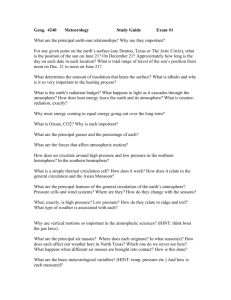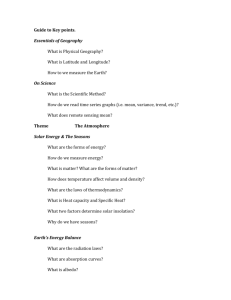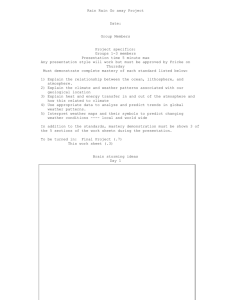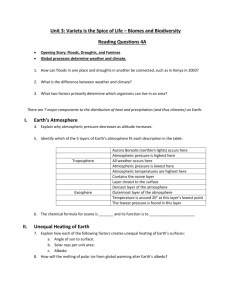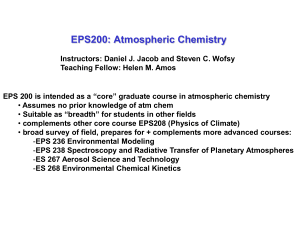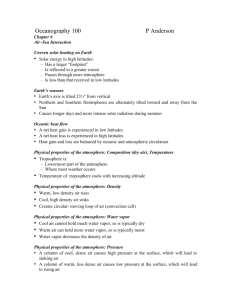Coriolis force
advertisement
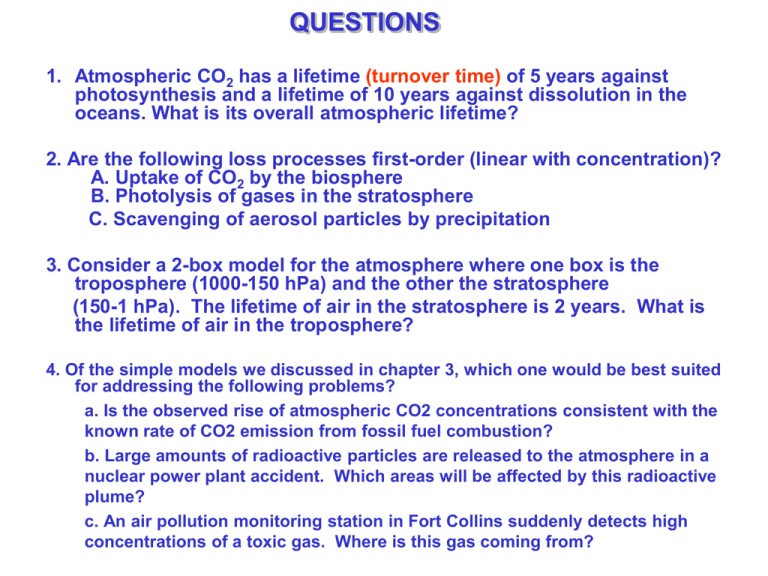
QUESTIONS 1. Atmospheric CO2 has a lifetime (turnover time) of 5 years against photosynthesis and a lifetime of 10 years against dissolution in the oceans. What is its overall atmospheric lifetime? 2. Are the following loss processes first-order (linear with concentration)? A. Uptake of CO2 by the biosphere B. Photolysis of gases in the stratosphere C. Scavenging of aerosol particles by precipitation 3. Consider a 2-box model for the atmosphere where one box is the troposphere (1000-150 hPa) and the other the stratosphere (150-1 hPa). The lifetime of air in the stratosphere is 2 years. What is the lifetime of air in the troposphere? 4. Of the simple models we discussed in chapter 3, which one would be best suited for addressing the following problems? a. Is the observed rise of atmospheric CO2 concentrations consistent with the known rate of CO2 emission from fossil fuel combustion? b. Large amounts of radioactive particles are released to the atmosphere in a nuclear power plant accident. Which areas will be affected by this radioactive plume? c. An air pollution monitoring station in Fort Collins suddenly detects high concentrations of a toxic gas. Where is this gas coming from? CHAPTER 4: ATMOSPHERIC MOTIONS and TRANSPORT WHAT ARE THE FORCES BEHIND ATMOSPHERIC CIRCULATION? 1. Global Circulation as a Giant Sea Breeze. Concepts: Pressure Gradient Force; visualizing pressure with isobars 2. Introduction to the Coriolis Force (with a supporting role played by angular momentum). We want to explain circulation patterns like these, which take place over large enough scales that the rotation of the earth has an effect on moving air parcels: TRANSPORT & ATMOSPHERIC CHEMISTRY The important role of circulation for atmospheric chemistry: 1. Dilute: concentrations of chemical species in a large volume of air 2. Transport: emissions away from sources 3. Mix: Promote oxidation by bringing various chemical constituents into contact 4. Cloud formation: promote aqueous phase chemistry CHAPTER 4: ATMOSPHERIC TRANSPORT Forces in the atmosphere: • Gravity g • Pressure-gradient γ p 1/ P • Coriolis c 2v sin to R of direction of motion (NH) or L (SH) • Friction γ f kv Equilibrium of forces: In vertical: barometric law p P In horizontal: geostrophic flow parallel to isobars v c P + DP In horizontal, near surface: flow tilted to region of low pressure p f v c P P + DP CORIOLIS FORCE An observer sitting on the axis of rotation (North Pole) launches a projectile at the target. The curved arrow indicates the direction of rotation of the earth. The projectile follows a straight-line trajectory, when viewed by an observer in space, directed towards the original position of the target. However, observers and target are rotating together with the earth, and the target moves to a new position as the projectile travels from launch to target. Since observers on earth are not conscious of the fact that they and the target are rotating with the planet; they see the projectile initially heading for the target, then veering to the right. The Coriolis force is a fictitious force introduced to the equations of motion for objects on a rotating planet, sufficient to account for the apparent pull to the right in the Northern hemisphere or to the left in the southern hemisphere. The geometry of the earth, showing the distance from the axis of rotation as a function of the latitude . r = R cos (R=6370 km) r =the distance from the axis of rotation R cos R R An object on the earth’s surface at a high latitude has less angular momentum (L=r x p = RcosmvE) than an object on the surface at a low latitude. Translational speed: vE = 2Rcos( ) / t Rotation axis Coriolis Force (Northern Hemisphere): • An air parcel (mass) begins to move from the Equator toward North Pole along the surface of the earth. • The parcel moves closer to the axis of rotation: r decreases • The parcel’s angular velocity is GREATER THAN the angular velocity of the earth’s surface at the higher latitude. It deflects to the right of it’s original trajectory relative to the earth’s surface. In the Southern Hemisphere, the parcel would appear to deflect to the left. The air parcel is deflected to the right. We thus find in all cases that the Coriolis force is exerted perpendicular to the direction of motion, to the RIGHT in the Northern Hemisphere and to the LEFT in the Southern Hemisphere. Angular velocity of the Earth=2π/day Coriolis acceleration( c) = F/m = 2v sin( ). Coriolis acceleration increases as (latitude) increases, is zero at the equator. DEFLECTION OF AN OBJECT BY THE CORIOLIS FORCE Dy = [ (Dx)2 / v ] sin() (a) A snowball traveling 10 m at 20 km/h in Fort Collins (40.6°N): v = 20 km/hr = 5.5 m/s; =7.5 10-5 s-1 ; sin ()=.65; Dx=10 Dy = 8.9 10-4 m (b) A missile traveling 1000 km at 2000 km/h at 40.6°N. v = 555 m/s, Dx=1 106 m; Dy = 8.8 104 m. In Fort Collins ( = 40.6N), we find that a snowball traveling 10 m at 20 km/h is displaced by Dy = 1 mm (negligible), but a missile traveling 1000 km at 2000 km/h is shifted 100 km (important!). Note the importance of (Dx)2 c = 2 v sin () ; t = Dx/v Dy = ½ c t2 GEOSTROPHIC FLOW low pressure Pressure gradient force N 1 P P high pressure S Motion of an air subjected to a north/south pressure gradient. Pt. A1, initially at rest; Pt. A3, geostrophic flow. The motion approaches geostrophic balance in a simple manner because atmospheric mass will be redistributed to establish a pressure force balanced by the Coriolis force, and motion parallel to the isobars. GEOSTROPHY For air in motion, not on the equator, •Coriolis Force Pressure gradient force •Air motion is parallel to isobars The geostrophic approximation is a simplification of very complicated atmospheric motions. This approximation is applied to synoptic scale systems and circulations, roughly 1000 km. (It is easiest to think about measuring the pressure gradient at a constant altitude, although other definitions are more rigorous. ) Vgeostrophic= 1 P 2 sin( ) X DP/DX Vg Dx DP geostrophic wind (m/s) 7.29 10-5 radian/s latitude distance (m) pressure diff. (N/m2) Circulation of air around regions of high and low pressures in the Northern Hemisphere. Upper panel: A region of high pressure produces a pressure force directed away from the high. Air starting to move in response to this force is deflected to the right (in the Northern Hemisphere), giving a clockwise circulation pattern. keep high pressure on the right Lower panel: A region of low pressure produces a pressure force directed from the outside towards the low. Air starting to move in response to this force is also deflected to the right, rotating counter-clockwise. Directions of rotation of the wind about high or low centers are reversed in the Southern Hemisphere, as explained earlier in this chapter. THE EFFECT OF FRICTION Friction: loss of air momentum to surface obstacles such as trees, buildings… exerted in opposite direction to the motion Friction slows the wind relative to its geostrophic velocity. This slowdown decreases the Coriolis acceleration so that air is deflected towards the low pressure region. CONVERGENCE AND DIVERGENCE THE HADLEY CIRCULATION (1735): global sea breeze COLD HOT Explains: • Intertropical Convergence Zone (ITCZ) • Wet tropics, dry poles •General direction of winds, easterly in the tropics and westerly at higher latitudes Hadley thought that air parcels would tend to keep a constant angular velocity. Meridional transport of air between Equator and poles results in strong winds in the longitudinal direction. COLD Problems: 1. does not account for Coriolis force correctly; 2. circulation does not extend to the poles. TROPICAL HADLEY CELL • Easterly “trade winds” in the tropics at low altitudes • Subtropical anticyclones at about 30o latitude CLIMATOLOGICAL SURFACE WINDS AND PRESSURES (July) CLIMATOLOGICAL SURFACE WINDS AND PRESSURES (January) TIME SCALES FOR HORIZONTAL TRANSPORT (TROPOSPHERE) 1-2 months 2 weeks 1-2 months 1 year IMPORTANCE OF MID-LATITUDE CYCLONES FOR US VENTILATION • Cold fronts associated with cyclones tracking across southern Canada are the principal ventilation mechanism for the eastern US • The frequency of these cyclones has decreased in past 50 years, likely due to greenhouse warming Leibensperger et al. [2008] GLOBAL DISTRIBUTION OF AEROSOL OPTICAL DEPTH NASA/MODIS satellite instrument (April 2001) Notice sharp boundary at ITCZ! VERTICAL TRANSPORT: BUOYANCY • What is buoyancy? Balance of forces: FP-gradient buoyancy P gradient gravity g z+Dz Fluid (’) Object ( z Fg Note: Barometric law assumed a neutrally buoyant atmosphere with T = T’ T P gradient gravity T’ would produce bouyant acceleration ATMOSPHERIC LAPSE RATE AND STABILITY “Lapse rate” = -dT/dz Consider an air parcel at z lifted to z+dz and released. It cools upon lifting (expansion). Assuming lifting to be adiabatic, the cooling follows the adiabatic lapse rate G : z stable G = 9.8 K km-1 g G dT / dz 9.8 K km-1 Cp z unstable inversion unstable What happens following release depends on the local lapse rate –dTATM/dz: ATM • -dTATM/dz > G e upward buoyancy amplifies (observed) initial perturbation: atmosphere is unstable • -dTATM/dz = G e zero buoyancy does not alter perturbation: atmosphere is neutral • -dTATM/dz < G e downward buoyancy relaxes T initial perturbation: atmosphere is stable • dTATM/dz > 0 (“inversion”): very stable The stability of the atmosphere against vertical mixing is solely determined by its lapse rate. WHAT DETERMINES THE LAPSE RATE OF THE ATMOSPHERE? • • An atmosphere left to evolve adiabatically from an initial state would eventually tend to neutral conditions (-dT/dz = G at equilibrium Solar heating of surface and radiative cooling from the atmosphere disrupts that equilibrium and produces an unstable atmosphere: z z ATM G z final G ATM T Initial equilibrium state: - dT/dz = G G initial T Solar heating of surface/radiative cooling of air: unstable atmosphere T buoyant motions relax unstable atmosphere back towards –dT/dz = G • Fast vertical mixing in an unstable atmosphere maintains the lapse rate to G. Observation of -dT/dz = G is sure indicator of an unstable atmosphere. IN CLOUDY AIR PARCEL, HEAT RELEASE FROM H2O CONDENSATION MODIFIES G Wet adiabatic lapse rate GW = 2-7 K km-1 z T RH “Latent” heat release as H2O condenses RH > 100%: Cloud forms GW 2-7 K km-1 G 9.8 K km-1 100% GW G T If Gw< -dT/dz < G air parcel is conditionally unstable SUBSIDENCE INVERSION typically 2 km altitude VERTICAL PROFILE OF TEMPERATURE Mean values for 30oN, March Altitude, km Radiative cooling (ch.7) - 3 K km-1 2 K km-1 Radiative heating: O3 + hn e O2 + O O + O2 + M e O3+M heat Radiative cooling (ch.7) - 6.5 K km-1 Latent heat release Surface heating DIURNAL CYCLE OF SURFACE HEATING/COOLING: ventilation of urban pollution z Subsidence inversion MIDDAY 1 km G Mixing depth 0 NIGHT MORNING T NIGHT MORNING AFTERNOON EFFECT OF STABILITY ON VERTICAL STRUCTURE What you see… Puffy little clouds, called fair weather cumulus, occurring over land on a typical afternoon. The lapse rate in the mixed layer is approximately adiabatic, and air parcels heated near the ground are buoyant. Each little cloud represents the top of a buoyant plume. (Photograph courtesy University of Illinois Cloud Catalog). PLUME LOOPING, BALTIMORE ~2pm. z T PLUME LOFTING, BEIJING ~7am z T TYPICAL TIME SCALES FOR VERTICAL MIXING How fast does air mix due to molecular diffusion? Use Fick’s Law: C F naD z Flux is proportional to the spatial gradient And the Einstein Equation for Molecular Diffusion: Dx Dt 2D 2 with D 2 -1 0.2cm s Find that will take 6.9 hrs to travel 1 m! molecular diffusion is unimportant as a means of transport and mixing at sea level (becomes important above 100 km) TYPICAL TIME SCALES FOR VERTICAL MIXING Define by analogy the time Dt to travel Dz by turbulent diffusion: Dz Dt 2 2K z with K z ~ 5 2 -1 10 cm s tropopause (10 km) 10 years 5 km “planetary 2 km boundary layer” 0 km 1 month 1 week 1 day

